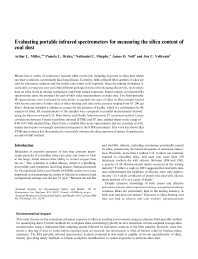Mining Publication: Evaluating Portable Infrared Spectrometers for Measuring the Silica Content of Coal Dust
Original creation date: January 2012
Miners face a variety of respiratory hazards while on the job, including exposure to silica dust which can lead to silicosis, a potentially fatal lung disease. Currently, field-collected filter samples of silica are sent for laboratory analysis and the results take weeks to be reported. Since the mining workplace is constantly moving into new and often different geological strata with changing silica levels, more timely data on silica levels in mining workplaces could help reduce exposures. Improvements in infrared (IR) spectroscopy open the prospect for end-of-shift silica measurements at mine sites. Two field-portable IR spectrometers were evaluated for their ability to quantify the mass of silica on filter samples loaded with known amounts of either silica or silica-bearing coal dust (silica content ranging from 10-200 µg/filter). Analyses included a scheme to correct for the presence of kaolin, which is a confounder for IR analysis of silica. IR measurements of the samples were compared to parallel measurements derived using the laboratory-based U.S. Mine Safety and Health Administration P7 analytical method. Linear correlations between Fourier transform infrared (FTIR) and P7 data yielded slopes in the range of 0.90-0.97 with minimal bias. Data from a variable filter array spectrometer did not correlate as well, mainly due to poor wavelength resolution compared to the FTIR instrument. This work has shown that FTIR spectrometry has the potential to reasonably estimate the silica exposure of miners if employed in an end-of-shift method.
Authors: AL Miller, PL Drake, NC Murphy, JD Noll, JC Volkwein
Peer Reviewed Journal Article - January 2012
NIOSHTIC2 Number: 20040039
J Environ Monit 2012 Jan; 14(1):48-55
See Also
- Best Practices for Dust Control in Coal Mining
- Control of Respirable Dust
- Crystalline Silica Analysis: A Comparison of Calibration Materials and Recent Coal Mine Dust Size Distributions
- Deposition Uniformity of Coal Dust on Filters and its Effect on the Accuracy of FTIR Analyses for Silica
- Direct-on-Filter alpha-Quartz Estimation in Respirable Coal Mine Dust using Transmission Fourier Transform Infrared Spectrometry and Partial Least Squares Regression
- Equivalency of a Personal Dust Monitor to the Current United States Coal Mine Respirable Dust Sampler
- Evaluation of Diffuse Reflection Infrared Spectrometry for End-of-Shift Measurement of α-quartz in Coal Dust Samples
- Examination of a Newly Developed Mobile Dry Scrubber (DS) for Coal Mine Dust Control Applications
- Exposure Monitoring of Dust and Toxic Substances
- Investigation into Dust Exposures and Mining Practices in Mines in the Southern Appalachian Region
- Laboratory Evaluation of a Canopy Air Curtain for Controlling Occupational Exposures of Roof Bolters
- Respirable Dust
- Content source: National Institute for Occupational Safety and Health, Mining Program


 ShareCompartir
ShareCompartir
